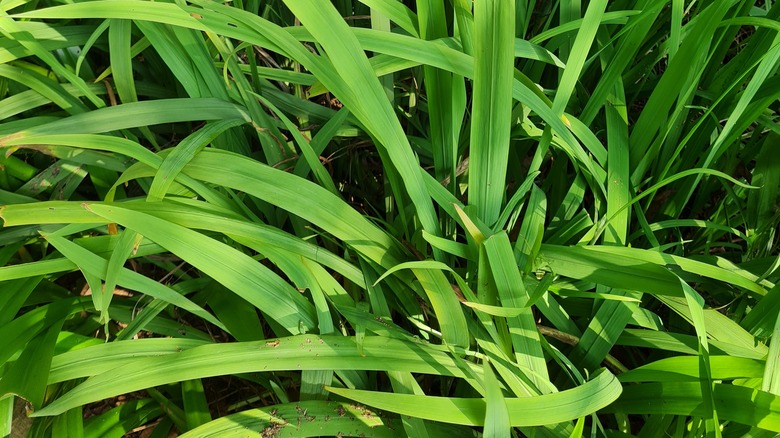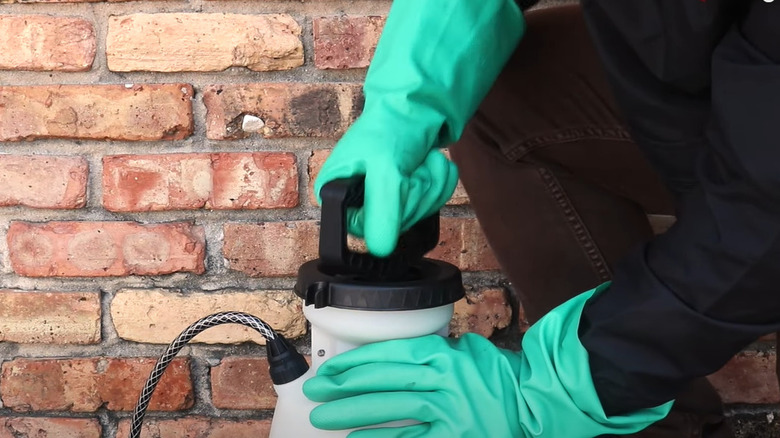Stop Hand-Pulling Quackgrass Weeds & Do This Instead
Quackgrass is quite the tenacious garden gatecrasher. With its lengthy stalks up to 4 feet and its blades shimmering in a grayish-greenish hue, it often masquerades as one of the non-invasive green companions like tall fescue, ryegrass, and blue wildrye. And its cunning doesn't end with its deceptive appearance; it's invasive. Beneath the surface, a network of deep-set, creeping rhizomes extends far beyond each visible tuft. This is no ordinary nuisance but the stuff of horticultural nightmares; it's not a surprise it goes by monikers that evoke nightmarish qualities, like witchgrass and devil's grass.
Given the root system stretches out up to 11 feet wide and tunnels 8 inches deep, trying to eliminate quackgrass by hand-pulling is as about as effective as mailing a letter with no address and will only invite more stubborn growth. Those deep, horizontal roots are adept at breaking off and playing the long game. The rhizome remnants will stay dormant in the soil, silently gathering energy until conditions are right for a resurgence that will likely muscle out other plants. And let's be honest, spending hours on your knees, locked in endless combat with quackgrass, is probably not how you envisioned spending time in your garden.
Now, having busted the weed-pulling myth around quackgrass, overcoming this invader demands a strategy as tenacious as its own survival instinct, which often necessitates the very last resort we dread: chemical interventions.
The best ways to get rid of quackgrass weed
Looking to get rid of quackgrass without harming desirable plants? Selective herbicides like fluazifop or sulfosulfuron could be a game-changer. An example would be the Certainty Turf Herbicide at Solutions Pest & Lawn ($101.15). On the flip side, if you're ready to clear the slate and don't mind sacrificing the other greenery, the heavy-hitters, non-selective herbicides like glyphosate and imazapyr, come in handy. For glyphosate-laced herbicide for quackgrass, check out Roundup Weed & Grass Killer Concentrate at Roundup ($19.99).
As for the best time to spray, aim for when quackgrass is still in its youth and growth spurt. Remember, these herbicides aren't exactly human-body-friendly, so wearing PPE isn't negotiable. In addition, spraying when it's calm goes a long way in thwarting plant-damaging, wind-induced herbicidal drifts. For a more precise strike, slip a sock on a golf stick head, dip it into a herbicidal solution, then gently dab it onto the quackgrass blades. However, it might take several rounds of herbicide applications to completely eradicate quackgrass.
Alternatively, you could cover minor infestations with a thick, sun-blocking cover like a black plastic tarp. Just make sure the covering is bigger than the problem area and pinned down at the edges with stones. It's like cutting off the oxygen to a fire — without the sun and with increased temperatures, quackgrass will hardly thrive. The only hitch is patience. You're looking at an operation that spans the whole growing season, usually around four months.
Plants that will make it hard for quackgrass to grow
Regarding using plants to control quackgrass growth, The University of Vermont advocates for playing with the seasons. Kick off with several rounds of tilling during summer. Then, as winter approaches, plant tough cover crops like winter rye or hairy vetch that hang on through the cold, or go with oats and field peas, which die off with the frost. That's supposed to leave a protective blanket that makes it tough for quackgrass to make a comeback in the spring.
However, a piece of advice from the Sustainable Agriculture Research and Education (SARE) feels a bit like a plot twist. They point out the less-thought-about consequences of crop rotation patterns. It turns out, planting spring cereal grains and legumes often might accidentally be giving quackgrass a leg up. You see, cereals are somewhat of a soft competition while legumes boost nitrogen in the soil, all rolling out the welcome mat for quackgrass during its vigorous spring growth phase. This perspective flips the script on the cover crop strategy, manifesting the complex relationship between what you plant, when you plant it, and managing pesky weeds.
So, where does that leave you in the war against quackgrass? Well, keep up the diligent tilling to dry out those stubborn resprouting rhizomes and lay down a protective layer of well-chosen weed-suppressing cover crops. Yet, remain mindful of the crop rotation choices that might be inadvertently helping the very green invader you want to conquer.


